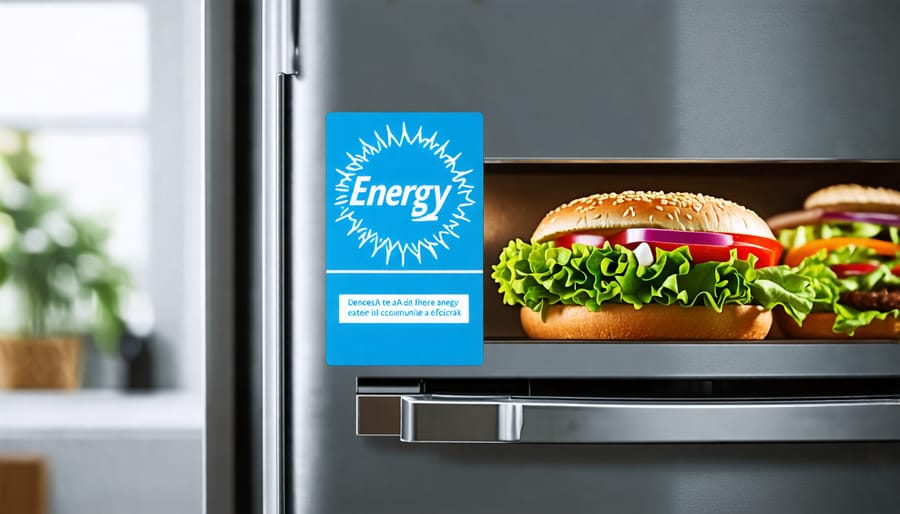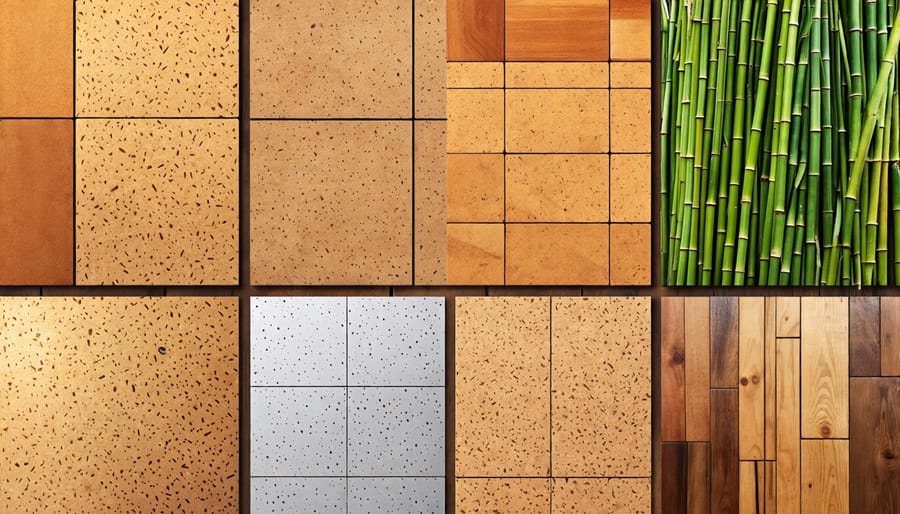Reduce your carbon footprint by adopting sustainable practices at home. Install energy-efficient appliances and LED bulbs to lower electricity usage. Opt for renewable energy sources like solar panels to power your energy-efficient home. Minimize water waste by fixing leaks, taking shorter showers, and collecting rainwater for gardening. Embrace eco-friendly transportation like biking, walking, or carpooling whenever possible.
Choose Energy-Efficient Appliances
Energy Star Ratings
Energy Star is a government-backed program that rates appliances and products based on their energy efficiency. The higher the star rating, the more energy-efficient the product is compared to similar models. For example, a refrigerator with a 5-star rating will use significantly less energy than a 2-star model. When shopping for new appliances, look for the Energy Star label and compare ratings to find the most efficient options. Choosing Energy Star certified products can lead to substantial energy savings over time, reducing your utility bills and environmental impact. Keep in mind that the most efficient models may have a higher upfront cost but will typically pay for themselves through long-term energy savings.

Long-Term Savings
Energy-efficient appliances may have a higher upfront cost, but they can lead to significant long-term savings on your utility bills. By using less energy to operate, these appliances reduce your monthly electricity and water expenses. Over the life of the appliance, these savings can add up to hundreds or even thousands of dollars. For example, an Energy Star certified refrigerator can save you over $200 in energy costs over its lifetime compared to a non-certified model. Similarly, an energy-efficient washing machine can cut your water and energy bills by up to 25%. When shopping for new appliances, look for the Energy Star label and compare the estimated annual operating costs to make an informed decision. Investing in energy-efficient appliances not only benefits the environment but also your wallet in the long run.
Switch to LED Lighting
Making the switch to LED lighting is one of the easiest and most effective ways to make your home more sustainable. LED bulbs are far more energy-efficient than traditional incandescent bulbs, using up to 90% less energy. This means you’ll see a significant reduction in your electricity bills, all while doing your part for the environment. LEDs also have a much longer lifespan than other bulbs, lasting up to 50,000 hours compared to just 1,000 hours for incandescent bulbs. This means you won’t need to replace them nearly as often, saving you time and money in the long run. Plus, LEDs come in a wide range of colors and brightness levels, so you can create the perfect ambiance in any room. When shopping for LED bulbs, look for the Energy Star label to ensure you’re getting a high-quality, efficient product. While LEDs may cost a bit more upfront, their long-term energy savings and durability make them a smart investment for any eco-conscious homeowner. So, whether you’re replacing a single bulb or upgrading your entire home, making the switch to LED is a bright idea for a greener future.

Install Low-Flow Fixtures
Installing low-flow fixtures is a simple and effective way to conserve water in your home without compromising performance. Low-flow faucets and showerheads reduce water usage by restricting the flow rate while maintaining adequate pressure for washing and rinsing. These fixtures typically use aerators or specialized designs to mix air with the water, creating a satisfying and efficient flow. Similarly, low-flow toilets use less water per flush, often employing a dual-flush system that allows you to choose between a partial or full flush depending on your needs. By replacing your standard fixtures with low-flow alternatives, you can significantly reduce your household’s water consumption, leading to lower utility bills and a smaller environmental footprint. Many modern low-flow fixtures are designed to provide a luxurious experience, with features like adjustable spray patterns and sleek, contemporary styles. When selecting low-flow fixtures, look for the WaterSense label, which indicates that the product has been independently certified to meet strict efficiency and performance criteria set by the U.S. Environmental Protection Agency. With a wide range of options available, from budget-friendly to high-end, there’s a low-flow fixture to suit every home and lifestyle.

Use Eco-Friendly Building Materials
When it comes to sustainable home improvements, choosing eco-friendly building materials is a great place to start. Bamboo flooring is an increasingly popular choice, thanks to its durability, affordability, and rapid renewability. This grass grows much faster than traditional hardwoods, making it a more environmentally responsible option. Cork is another sustainable flooring material that offers natural insulation, sound absorption, and a comfortable walking surface. It’s harvested from the bark of cork oak trees without harming the tree itself. For countertops, consider using reclaimed wood or recycled glass. These materials give your kitchen a unique, rustic charm while diverting waste from landfills. Recycled glass countertops are durable, low-maintenance, and available in a variety of colors and patterns. When shopping for furniture, look for pieces made from responsibly sourced materials like FSC-certified wood or organic cotton. Vintage and secondhand furniture are also eco-friendly choices that add character to your home. By incorporating sustainable materials into your home renovation projects, you can reduce your environmental impact without sacrificing style or quality. These eco-friendly options are not only good for the planet but can also improve your home’s energy efficiency, indoor air quality, and overall comfort. As you plan your next home improvement project, consider exploring the many beautiful and sustainable materials available to create a home that’s both stylish and green.
Improve Insulation
Proper insulation is a critical factor in creating an energy-efficient home. Without adequate insulation, your home can lose a significant amount of heat during the winter and let in unwanted heat during the summer. This leads to higher energy consumption as your heating and cooling systems work overtime to maintain a comfortable temperature. By investing in high-quality insulation materials and ensuring they are installed correctly, you can dramatically reduce energy waste and lower your utility bills. Start by assessing your home’s current insulation levels, paying close attention to the attic, walls, floors, and windows. If you notice drafts or inconsistent temperatures, it may be time to upgrade your insulation. Consider eco-friendly options like recycled denim, cellulose, or sheep’s wool, which offer excellent thermal properties while being sustainable and non-toxic. Don’t forget to seal gaps and cracks around windows and doors to prevent air leaks. Combining proper insulation with other energy-saving measures, such as using energy-efficient appliances and incorporating indoor plants to regulate humidity, can significantly improve your home’s overall energy efficiency and create a more comfortable living space.
Incorporate Plants
Incorporating plants into your home is not only aesthetically pleasing but also beneficial for improving indoor air quality. Plants naturally filter the air by absorbing toxins and releasing oxygen, making your living space healthier and more inviting. Some of the best air-purifying plants include snake plants, spider plants, peace lilies, and pothos. These low-maintenance options thrive in various light conditions and require minimal care, making them perfect for busy households or those new to plant parenthood. Simply place them in well-draining pots, water when the soil feels dry, and enjoy their vibrant green foliage. In addition to their air-purifying properties, indoor plants have been shown to reduce stress, boost mood, and increase productivity. By incorporating a few carefully chosen plants throughout your home, you can create a more sustainable and welcoming environment that promotes both physical and mental well-being.
Choose Low-VOC Paints and Finishes
When painting or finishing surfaces in your home, it’s essential to consider the potential health and environmental impacts of the products you use. Many traditional paints and finishes contain volatile organic compounds (VOCs), which are chemicals that can evaporate into the air at room temperature. Exposure to VOCs can lead to various health issues, such as headaches, dizziness, and respiratory problems, especially in poorly ventilated spaces. Additionally, VOCs contribute to air pollution and can have negative effects on the environment. Fortunately, there are eco-friendly alternatives available in the form of low-VOC products. These paints and finishes are specifically formulated to minimize the release of harmful chemicals, making them a safer choice for both your family and the planet. By opting for low-VOC options, you can significantly reduce indoor air pollution, creating a healthier living environment. Moreover, choosing eco-friendly products supports manufacturers who prioritize sustainability and encourages the development of more environmentally responsible solutions in the home improvement industry. When shopping for paints and finishes, look for products labeled as “low-VOC” or “zero-VOC.” Keep in mind that even low-VOC products may still contain some harmful chemicals, so it’s crucial to ensure proper ventilation during application and drying. By making informed choices and prioritizing low-VOC options, you can create a beautiful, sustainable home that promotes the well-being of both your family and the environment.
Opt for Sustainable Textiles
When selecting textiles for your home, opt for sustainable materials that are gentle on the environment. Organic cotton is a fantastic choice for curtains, throws, and upholstery fabric. It’s grown without harmful pesticides or chemicals, making it safer for you and the planet. Bamboo is another eco-friendly option, as it’s a fast-growing, renewable resource that requires minimal water and pesticides to cultivate. Bamboo fabrics are soft, durable, and naturally antimicrobial, perfect for creating a cozy and healthy home environment. If you’re looking for rugs or carpets, consider those made from recycled polyester. This material is crafted from post-consumer plastic bottles, diverting waste from landfills and giving it new life in your home. Recycled polyester rugs are stain-resistant, easy to clean, and come in a variety of colors and styles to suit your decor. By choosing sustainable textiles, you’re not only reducing your environmental impact but also creating a healthier living space for you and your family. These materials are often hypoallergenic, breathable, and free from harmful chemicals, promoting better indoor air quality. Plus, you can feel good knowing that your decorating choices are supporting responsible farming and manufacturing practices that prioritize the well-being of the planet and its people.
Reduce, Reuse, Recycle
Instead of buying new furniture, consider giving your old pieces a fresh look. Sand down and repaint a wooden coffee table, or reupholster a dated armchair with vibrant fabric. Get creative with decor by repurposing items you already have. Transform old mason jars into charming vases or candle holders, or use a vintage ladder as a unique bookshelf. When it comes to textiles, repurpose old curtains into throw pillow covers or a patchwork quilt. Turn worn-out sheets into reusable produce bags or cleaning rags. If you have old clothing, consider cutting it up and weaving it into a colorful rag rug. In the kitchen, repurpose glass jars as food storage containers or use them to organize small items like buttons or screws. Old dishes can be repurposed as planters or used to create a unique mosaic tabletop. For outdoor spaces, convert an old dresser into a potting bench or use reclaimed wood to build a rustic birdhouse. Repurpose old tires as colorful planters or turn them into a unique swing for kids. Remember, the key to reducing waste is to think creatively about how you can repurpose items you already have. Not only will you save money, but you’ll also create one-of-a-kind pieces that showcase your personal style. By embracing the concept of “reduce, reuse, recycle,” you’ll contribute to a more sustainable home and planet.
Educate Your Household
Making your home more sustainable is a team effort that requires everyone’s participation. Start by educating your household members about the importance of adopting eco-friendly practices. Explain how small changes, like turning off lights when not in use or taking shorter showers, can make a big impact on your home’s environmental footprint. Encourage open discussions and brainstorm ways to reduce waste, conserve energy, and make more sustainable choices together. Lead by example and make it easy for your family to adopt sustainable habits. Place recycling bins in accessible locations, use reusable bags for shopping, and opt for eco-friendly cleaning products. Assign age-appropriate tasks to children, such as sorting recyclables or tending to a small herb garden, to help them feel involved and responsible. Make sustainability fun by setting household challenges, like competing to see who can take the shortest shower or creating a game out of finding new ways to repurpose old items. Celebrate your successes together and discuss areas where you can improve. Remember, building a sustainable home is an ongoing journey, and every small step counts. By working together and supporting each other, you can create a more environmentally conscious household that benefits both your family and the planet.
